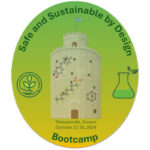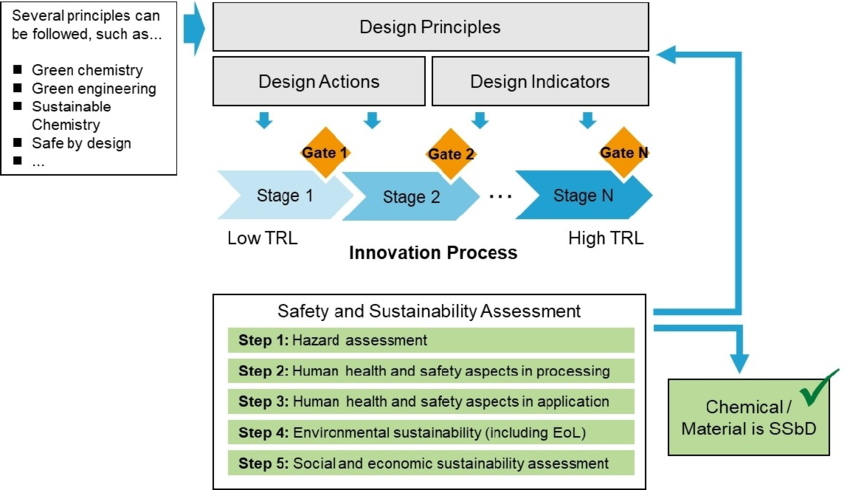
Workshop 2nd SSbD Boot Camp – October 2024
Ottobre 16, 2024
The Importance of SSbD in the Textile Industry
Ottobre 29, 2024Safe and Sustainable by Design (SSbD) Chemicals and Materials: Methodological Guidance Overview
The Safe and Sustainable by Design (SSbD) Methodological Guidance provides a comprehensive and structured approach to the voluntary implementation of the SSbD framework for chemicals and materials. This framework integrates the disciplines of Risk Assessment (RA) and Sustainability Assessment (SA), both of which use different methodologies, terminologies, and perspectives. By combining these approaches, the guidance aims to create safer and more environmentally sustainable chemicals and materials throughout their entire life cycle. The guidance also responds to stakeholder feedback gathered from consultations, contributing to the refinement of the framework and ensuring that it aligns with real-world challenges and innovations.
The SSbD Framework: Structure and Goals
The SSbD Framework is a flexible and adaptable approach that can be applied to the design, development, and production of both new chemicals and materials, as well as the re-assessment of existing ones. Its primary goal is to promote the substitution of hazardous chemicals and materials with safer, more sustainable alternatives, thereby reducing pollution and the environmental footprint of chemical production and use. By combining hazard and risk assessment methods with Life Cycle Assessment (LCA) techniques, the SSbD framework supports decision-making across the innovation process, from early-stage design to full-scale production and application.
Key Components of the SSbD Framework
The SSbD framework consists of two major phases: the (re)design phase and the 4-step assessment phase, with an additional optional step for socio-economic analysis.
- (Re)Design Phase:
- This phase is based on general SSbD design strategies and principles, which draw from existing concepts such as Green Chemistry, Green Engineering, Sustainable Chemistry, and Circularity.
- The design principles emphasize factors such as material efficiency, minimizing the use of hazardous substances, energy efficiency, the use of renewable resources, preventing hazardous emissions, reducing exposure to hazardous materials, designing for end-of-life, and considering the full life cycle of the product.
- 4-Step Assessment Phase:
- The assessment phase includes a structured, tiered evaluation process that incorporates both safety and sustainability elements.
- Step 1: Hazard Assessment: This involves identifying hazards, gathering data for hazard classification, and characterizing the maximum exposure limits of chemicals and materials.
- Steps 2 and 3: Safety Aspects in Production and Processing: These steps focus on identifying and assessing exposure during production, processing, and application stages. The framework offers guidance on how to characterize risk and identify potential safety concerns in these stages.
- Step 4: Environmental Sustainability Assessment: This step focuses on the use of Life Cycle Assessment (LCA) to assess the environmental impact of chemicals and materials. Depending on the maturity of the innovation, the LCA can be performed in tiers, with each tier providing more refined and detailed data as the innovation progresses. This step also includes narrowing system boundaries and generating data to guide innovation in an environmentally sustainable direction.
- Socio-Economic Step:
- In some cases, socio-economic factors are considered in the assessment process. This involves evaluating the economic and social impacts of chemicals and materials, such as cost, public health implications, and potential societal benefits.
Safety and Sustainability Assessments
The Safety Assessment section provides practical guidance on how to conduct a complete risk assessment for chemicals and materials. It covers:
- Hazard identification
- Hazard characterization
- Exposure assessment
The Environmental Sustainability Assessment focuses on conducting Life Cycle Assessment (LCA) according to the maturity of the innovation. LCA methods help innovators identify the environmental impacts of chemicals and materials across their life cycles, including production, use, and disposal. This tiered approach to LCA ensures that assessments are aligned with the data available at each innovation stage, helping refine the innovation in line with sustainability goals.
The SSbD Methodological Guidance is a vital tool for innovators and stakeholders working towards safer and more sustainable chemical innovations. By combining hazard and risk assessments with environmental and socio-economic sustainability assessments, the framework offers a holistic approach to the design and development of chemicals and materials. It aligns with the European Green Deal’s ambition of zero pollution and helps the chemical industry reduce its environmental footprint while promoting health, safety, and circularity across the EU’s economy.
For innovators, researchers, and industries aiming to align with EU sustainability objectives, the SSbD framework provides a flexible yet robust foundation for steering their products toward a safer, more sustainable future.


